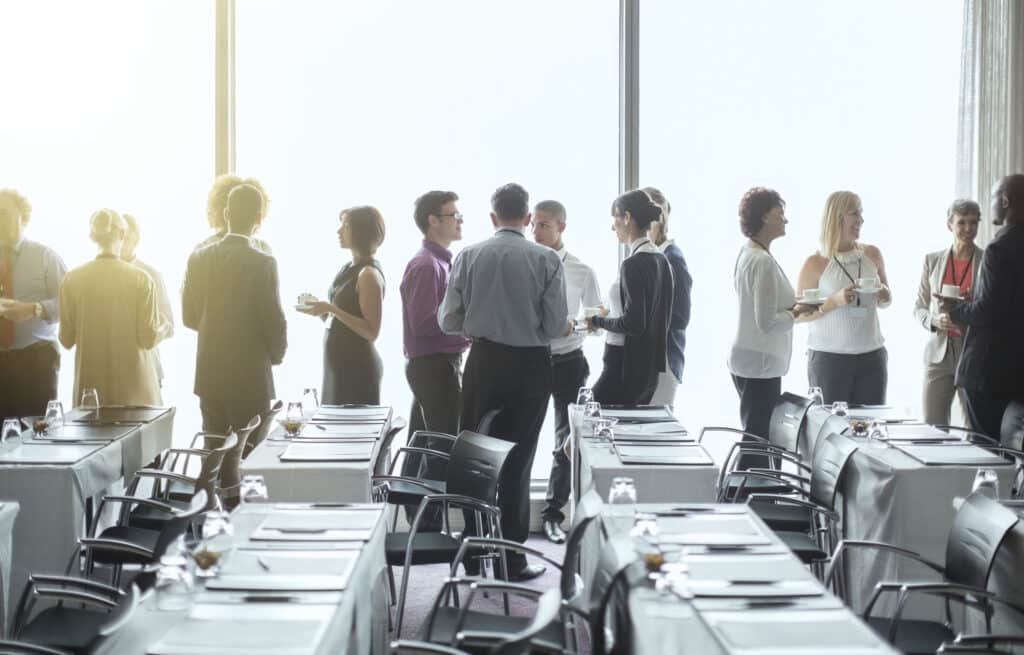Five Trends in Event Planning Taking Hold in 2023

Are we back yet? Are hotels ready for the numbers we’re seeing? Why are costs still so crazy high? You want to do a 250-person event four months from now? Are we safe? What do you mean you’re charging me for electricity in the meeting room?
These questions highlight the current environment surrounding planning meetings in 2023. The year is off to a strong start with our association client events exceeding attendee, sponsor, and revenue goals, some reaching record highs. And planning for 2024 and 2025 is showing no signs of slowing down. So, here are five trends to keep you on your toes and adjust to this climate of chaos!
1. Diversity, Equity, Inclusion, and Accessibility
As associations have honed their DEIA strategies, there is progress but a lot more work to be done. In event planning, it is vital that these strategies translate into accommodations and programming that align with DEIA goals.
Start with a full understanding of your association’s DEIA strategy and policies. Make sure all team members and outside contractors know what is expected. Inventory your event websites and registration forms for DEIA-driven fields and options. Make the program committee diverse and committed to bringing DEIA content, speakers, scholarships, pricing models, and accessibility options for attendees. Collect data that can help enhance DEIA efforts at future meetings. On post-conference surveys, ask participants for feedback on diversity, inclusion, and accessibility. Ensure event websites are ADA compliant and follow WCAG accessibility guidelines. Add options for name pronunciation and pronouns to your registration form. Include learning preferences on registration forms. Offer space for attendees to include any ability-related needs when registering, such as wheelchair accessibility or auditory and sensory impairments. Ask questions about preferred communication style. Lastly, include a community agreement on the form for all attendees to abide by the policies that support the DEIA strategy.
2. Creative Price Hikes from Hotels and AV
As costs go up on just about every aspect of meeting planning—and not just higher room rates, AV, and food and beverage (F&B) pricing—it is important to carefully read contracts and negotiate with more due diligence than ever before.
Some things to watch out for:
- Mandatory resort fees, even at properties without any “resort” amenities!
- Increased services fees—the highest we’ve seen is between 26 to 28%. These fees are being charged not just to F&B, but to AV and room rental fees. Negotiate heavier discounts on F&B and AV to offset the higher service charges.
- Electricity fees—at a recent conference, the property wanted to charge us for using their wall outlets.
- Room set-up fees—some hotels are beginning to charge room set-up fees. One way to offset some of these rental fees is to consider negotiating a slightly higher F&B minimum in return for lower or no set-up fees.
3. Personalization
Attendees expect a personalized experience, and event planners will use data analytics to offer unique event experiences for each attendee.
Event planners need to consider neurodiversity elements to every meeting. Neurodiversity relates to the range of differences in individual brain function and behavioral traits that impact learning preferences, abilities, personalities, and health needs. You may have a wide variety of attendees that view and process information differently. For this reason, and to better personalize the experience, consider the following:
- Include the option to choose learning preferences on your event registration form.
- Hire sign language interpreters and offer materials in alternative formats, such as braille or large print.
- Reserve seating in each session and keynote for those with auditory disabilities and assistive devices, such as wheelchairs.
- Ensure post-event videos have captions, transcripts, and language translation options.
- Feature a variety of session types throughout your event, such as roundtables, small-group activities, and fireside chats.
4. AI & Digital Transformation of meetings
Event planners are embracing digital transformation to streamline processes, enhance communication, and increase efficiency. This includes the use of event management software, mobile apps, and online ticketing platforms. For those with larger budgets, Augmented Reality (AR) and Virtual Reality (VR) technologies are expected to be more widely used in event planning in 2023. These technologies can provide immersive experiences, making events more engaging and interactive.
Artificial Intelligence or AI has the potential to revolutionize the way conferences are marketed and produced by gaining valuable insights into their target audience, optimizing their marketing efforts, and streamlining production. Multiple platforms have been using AI for several years. Matchmaking is the most common use, but AI is also used for content recommendation, translation, and data analytics, to name a few.
ChatGPT can now be used to generate ideas for speakers, topics, venues, and entertainment options for planners. Event apps are widely used, and we now have the opportunity to learn and improve with every event we attend. With it’s capability to learn, AI will ensure attendees feel like they have a personal assistant tailored to their needs. You can have event schedules, documents, registration capabilities, as well as the ability to incorporate on-demand chat features. These features allow for smoother event launches, while maintaining a high level of attendee assistance with minimal human interaction. And with the need for less staffing, the cost of using these event applications is countered by the reduced cost in temporary staffing.
Chatbots are similar to event apps, and provide a conversational tool that can emulate how a human will respond to site visitors and event app users by answering questions and maintaining conversation. The ability to integrate chatbots into messaging apps the users already own without downloading an additional app or extension adds to the feature’s usability.
Some AI technologies to keep an eye on when event planning are:
5. Sustainability
Sustainable events will continue to gain momentum in 2023. There will continue to be a focus on reducing waste, energy consumption, and the use of sustainable materials. But the idea of sustainability is reaching further into the realm of “responsibility”, incorporating issues like labor, human rights, community based economic impact, “shop/source local”, political implications of venue/city/state selection, supply chain and ethically sourced materials.
Meeting planners must be knowledgeable on so much more. At a recent IMEX education session, we learned that if planners aren’t educating, advocating, and implementing sustainability measures then nothing will ever change. Education is necessary to raise awareness about the importance of sustainability among stakeholders, including clients, vendors, and attendees. Advocacy involves actively promoting and supporting these measures by encouraging clients to choose eco-friendly venues or vendors. Implementation refers to taking concrete actions to reduce the environmental impact of events, such as reducing waste, conserving energy, and minimizing transportation emissions. Without a concerted effort on all three fronts, progress towards sustainability is unlikely to occur. IMEX has aggregated a great deal of data and research on this topic.
For continued education and certification in sustainable meeting planning, here are a few organizations that provide the tools needed to build a successful program.
- The Events Industry Council Sustainable Event Professional Certificate Programme
- Institute for Sustainable Events
- MPI’s Sustainable Event Strategist program
Planners in 2023 have their work cut out for them! Remember the subtraction theory – take away things that offer no value and waste time, and replace them with meaningful tasks that achieve the impact you are looking for. By incorporating these trends into planning, you can navigate the current environment and offer attendees a meaningful and worthwhile experience.
Tags
Related Articles
Recent Study Shows Conferences Contribute to Long-Term Sustainability for Host Cities
Dig into the data in this article provided by Destination Vancouver.
Revolutionize Event Engagement
Discover how one association reimagined its approach to spotlighting start-ups in order to better connect...
The Key to Choosing the Right Keynote
Bonnie Stetz, CMP, of the NATIONAL ASSOCIATION OF REALTORS® shares tips on choosing the right...





